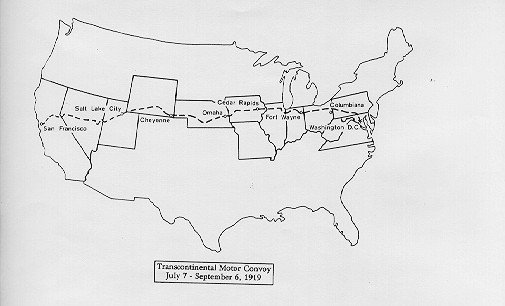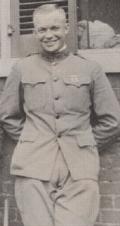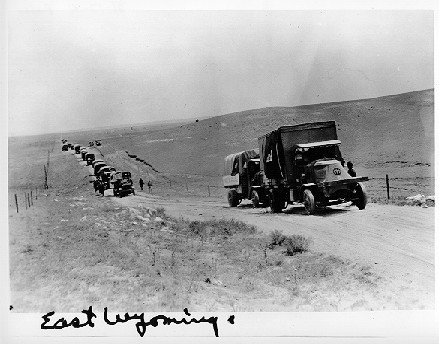1919 Transcontinental Motor Convoy
"In the summer of 1919, a young Lieutenant Colonel named Dwight D. Eisenhower participated in the first Army transcontinental motor convoy. The expedition consisted of eighty-one motorized Army vehicles that crossed the United States from Washington, D.C. to San Francisco, a venture covering a distance of 3,251 miles in 62 days. The expedition was manned by 24 officers and 258 enlisted men. The major objectives of the expedition were to test various military vehicles, many developed too late for use in World War I, and to determine by actual experience the feasibility of moving an army across the continent. A sense of realism was added by operating the convoy under wartime conditions. In the words of the Expeditionary Adjutant Officer it was assumed..."that railroad facilities, bridges, tunnels, etc. had been damaged or destroyed by agents of an Asiatic enemy. The expedition was assumed to be marching through enemy country and therefore had to be self-sustaining throughout".... Colonel Eisenhower and Major Sereno Brett, joined the convoy the first night out of Washington in Frederick, Maryland as Tank Corps observers. There were 24 expeditionary officers, thirteen other War Department staff observation officers, and 258 enlisted men with the convoy. It was to proceed to San Francisco via the Lincoln Highway (now U.S. 30), a series of roads that "varied from average to non-existent." Ike wrote that the trip was a genuine adventure. "We were not sure it could be accomplished at all. Nothing of the sort had ever been attempted."
"But the convoy had a serious mission and was overall a great success. Written reports now part of the Eisenhower Library archival holdings show that much valuable information about the performance of various makes and sizes of trucks, types of tires, and repair equipment was gained through the expedition. The public relations aspect of the trip was a success, too. Passing through about 350 communities in eleven states plus the District of Columbia, the convoy was witnessed by approximately 3,250,000 people. Local publicity brought the convoy to the attention of an estimated additional 33,000,000 people across the country. Several hundred Army recruits were obtained as a direct result of the convoy. One report notes that "all along the route, great interest in the Good Roads Movement was aroused ... and it was reported that several states had voted favorably on large issues of road bonds." When Eisenhower became President over 30 years after the Transcontinental Motor Convoy, and after seeing the autobahns of Germany during World War II, one of his top priorities was the building of a interstate highway system in the United States. In At Ease he wrote, "The old convoy had started me thinking about good, two-lane highways, but Germany had made me see the wisdom of broader ribbons across the land." (At Ease, pp. 166-67)"
Links:
- Text and photos from 1919 Transcontinental Motor Convoy at Eisenhower Library includes documents
- 20th Century Roads from CNN
- Lincoln Highway Association includes video for sale
- Lincoln Highway Museum in Galion Ohio
- photo from Ames Library
- Davies, Pete. American Road. New York: Holt, July 2002. "On July 7, 1919, an extraordinary cavalcade of sixty-nine military motor vehicles set off from the White House on an epic journey. Their goal was California, and ahead of them lay 3,250 miles of dirt, mud, rock, and sand. Sixty-two days later they arrived in San Francisco, having averaged just five miles an hour. Known as the First Transcontinental Motor Train, this trip was an adventure, a circus, a public relations coup, and a war game all rolled into one. As road conditions worsened, it also became a daily battle of sweat and labor, of guts and determination."


